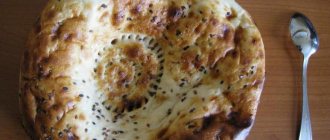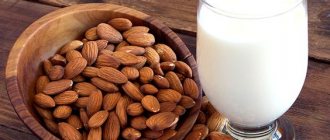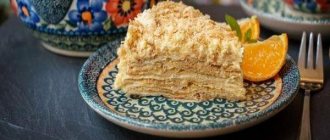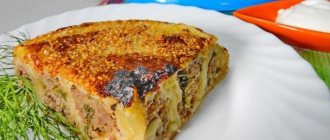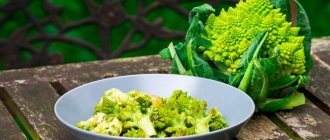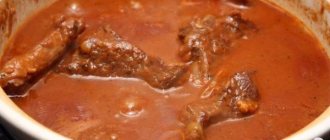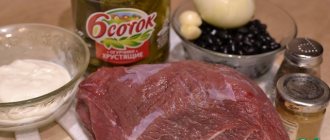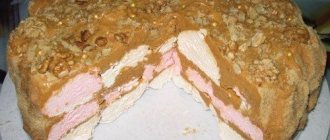Reviews (2)
8
Updated: Dashuta
04/23/2014 Cooking time: 40 min
| Save | I cooked) | Estimate |
Instead of the usual bread, today I suggest you prepare incredibly tasty Kazakh flatbreads shelpek - they are perfect for your everyday diet, and will diversify your menu during Lent!
What is helpek?
This is the name for flat cakes made from different types of dough, fried in a large amount of fat in a frying pan, which replace bread. Shelpek in Kazakh style can be soft and rich from yeast dough, or it can be unleavened, with a crispy crust, made from water and flour. In different culinary traditions of the world there are similar flatbreads: in Russia - “khvorost” because of the crispy dough cut into strips, in Ukraine - “ushki”, so called because of the softness of the finished product made from yeast dough, krupuk - in Indonesia, chalpak - in Uzbekistan, langoshi - among the Hungarians.
But Kazakh flatbreads have a peculiarity - they are fried only on special days, on major religious holidays or funerals, so the recipe for helppek is jealously passed down in the family as a family heirloom. Each kitchen owner has her own twist in cooking.
Everything about the Kazakh national flatbread “shelpek”: past and present, myths and reality.
- Kazakh shelpeks - a copy of Indian fried flatbreads
Once upon a time, I was given a small book in Russian, “The Tsar’s Feast is Affordable for Everyone,” with 32 recipes for Indian vegetarian dishes.
And I was very, very surprised by the recipes from the “Bread” section - “Simple Indian flatbreads (puri, chapati)” and “Fried fluffy flatbreads (bhatura)”, since they absolutely coincided with the recipes of our Kazakh “shelpek” (helpek, shelpek) - traditional thin flatbreads made from wheat flour, which our grandmothers and mothers always fried in well-heated oil in a frying pan. I also had the opportunity to visit the cozy Indian restaurant “Namaste” a couple of times in Almaty, where I had the opportunity to visually verify and feel the complete similarity of the taste of Indian flatbreads with our round “shelpeks”. In Kazakh cuisine, there are varieties of shelpek: yeast-free, thin, crispy, including those cooked in a dry, hot frying pan without oil (this is “karma”, an analogue of “chapati”), layered with onions (“kattama nan”), or lush , with yeast or kefir (bhatura recipe). In the best historical eras and in a semi-sedentary life (especially in marginal zones such as Semirechye, Southern Kazakhstan), the Kazakhs baked other types of flat cakes, “patyr nan”, “tandyr nan”, developed and improved their culinary traditions in close cooperation with related Muslim peoples world and the East in general.
But in general, just like millions of poor families of the Hindustan Peninsula, most of the Kazakhs in the past, first due to the unsophisticated lifestyle of the nomads, the high degree of militarization of everyday life, and later the growing mass impoverishment, colonization, migration, living in tents, had the ability to prepare traditional bread not in the form of tandoor flatbreads, pita bread, etc. (since they require a stationary clay oven), but in the form of “helpek” - fried round thin bread, quickly cooked in a heated frying pan or cauldron, which is usually served hot..
- Shelpeks as a memory of the past, a parallel with fried turkey on Thanksgiving Day in the USA.
They were an important and constant element of the simple meal of many generations of Kazakhs of the new and modern era. One can even say that these ruddy hot cakes, consecrated by love, warmed by the warmth of the palms and quiet prayers of millions of long-suffering and wise Kazakh women, became for us a kind of symbol of the harsh everyday life of the last centuries of national history, when we, the Kazakhs, were seriously tested by God the Almighty . It's like in the United States, they always cook roast turkey on Thanksgiving Day. And this is done in memory of how the first colonists survived with the help of the Indians, the latter gave them advice and also treated them to turkey meat...
So for us, these round Kazakh shelpeks are not just a traditional bread product, but also an eternal reminder to today’s prosperous descendants of the ordeals and self-survival of large families of former cattle breeders on the vast territory of the Kazakh Steppe. When they were first deprived of meat and dairy products, they were forced to switch entirely to a low-calorie diet of only cereals (all remaining things, fur coats, jewelry, etc. were then exchanged for flour and millet in the markets).
Looking at the Shelpeks, I am often overcome with sadness. My historical memory recreates a painfully dear and sad image of a poor Kazakh village, dusty, barefoot and always malnourished our fathers and grandfathers, who grew up on wheat soup, rejoicing at their grandmother’s fried flatbreads and baursaks with black tea (and at the peak of Asharshylyk, many of them they whined pitifully and with undying hope in their eyes looked towards the overturned cold cauldron). By the way, the overturned “dead” black cauldron, as well as the fallen and broken shanyrak (wooden dome of the yurt) should be considered visual symbols of the national tragedy of the Kazakhs - the Great Famine of the 30s.
- The flatbread “shelpek” is the main bread product at the Kazakh dastarkhan and an indicator of the civilizational identity of the people.
Flatbread “shelpek” (helpek) is, without any doubt, our past, our culture and history, the memory of our ancestors (it’s not for nothing that seven flatbreads are fried and the Koran is read). But shelpek is also the main bread product in our national cuisine, along with baursak, which is almost identical in dough composition (the latter have the shape of round balls, koloboks). For example, lavash was included in the UNESCO list of intangible heritage, but there is debate about why it is called Armenian bread. Also, everyone says “Uzbek flatbreads”, “Turkish kebab”, etc. But the technology of shish kebab belongs to the nomads, when during campaigns nomadic warriors roasted game and lamb on spits? And the dastarkhans of our khans and sultans always included “khan-palau” (“khan’s pilaf”), traditional cheese (“irimshik”, etc.).
Who benefits from presenting us to the world as the most primitive meat-eaters? It’s good that raw food diet and pagan blood sausage (Mongolian-Kalmyk) have not yet been attributed to us. Although even the Mongols, in fact, in the best periods of history, ate additional vegetables and grains, buying them from the Chinese and other neighbors.
Further, it is the round eastern flatbread that is an indicator of the civilizational identity of the Kazakhs, because with an honest, conscientious analysis, it again turns out that not the Siberian tundras and the Gobi Desert, but Central Asia, Iran, India and Pakistan, the Middle East have always been civilizational landmarks for our ancestors. The Kazakhs call bread “nan”, and this is a Persian word that has even penetrated into Indian culture (“naan”). Of course, this is the influence of the Great Silk Road and Islam.
In the pre-colonial era, a Kazakh girl braided 20-40 small “Uzbek” braids and wore oriental trousers under her dress. As a true daughter of nomadic conquerors, descendants of the “gold-guarding” Scythians and the elite of the Golden Horde, she wore up to 20 kg (!) of massive gold jewelry, including a gold ring in her nose, thus more reminiscent of the heroines of the Indian TV series “Jodha” and Akbar" rather than the inhabitants of the wild prairies.
Finally, what is most important in the end, our national Kazakh flatbreads are just normal, very tasty and satisfying bread, if prepared with high quality, carefully, from good flour, in good butter and served hot. You can also wrap them with a variety of fillings and cook them with onions.
By the way, about the filling and recipe options for Kazakh shelpek. The fact is that this is again a factually and methodologically distorted question by the Kazakhs themselves. For example, in various books and materials on the Internet, ethnographers categorically write that Kazakh shelpeks, firstly, are supposedly not intended for wrapping meat filling in it or eating with cheese, herbs, etc. Secondly, supposedly (what an absurdity, though) !) Kazakh shelpek, unlike all its “sisters” - flatbreads of other peoples of the East - is supposedly only a ritual dish that is fried exclusively on Fridays “for the aruakhs”.
In fact, all this is complete nonsense, and speaks of the lack of logic and historical sense of these “experts”. Similar to the thoughtless denial of the existence of dances, flutes, drums, and gold women's jewelry among the Kazakhs in early eras. Nobody wants to see our tradition and history in dynamics, in its entirety, to delve into and take into account the fact that this people over the past 100 years has sharply become wild and impoverished, and its culture and tradition must be restored almost from scratch.
- Pilaf and flatbread are not only Uzbek, but also Kazakh cuisine!
Yes, the six million Kazakh people from the beginning. In the 20th century, he hung on the brink of life and death, was constantly starving, and even experienced mass famine with cannibalism (eating human corpses). Trade stopped a long time ago, all connections within the region and country, not to mention international trade, were interrupted. Although even at the end of the 18th century, Ivan Andreev noted such an important detail for us in relation to the Kazakhs of Eastern Kazakhstan: that these nomads are terribly greedy for spices, they love and look for ginger, garlic, etc. But by the 20s of the 20th century. residents of the same villages of East Kazakhstan region forgot what ginger or cloves are, and maybe they didn’t even know what garlic and onions looked like.
And so, we lived to the point that if only wheat flour appeared in a Kazakh’s house, it was already joy and rejoicing to the skies for our great-grandmothers and great-grandfathers. Of course, if there is simply nothing to put as a filling, there is nothing to dip the same shelpek with, because for a long time there is no trace of elementary onions, no sesame seeds, no meat - then, of course, shelpeks will remain just shelpeks. Find yourself in the place of the Kazakh. In the 20th century, any other person - Tajik, Turk, Hindu, French - he would also sit and eat just fried shelpeks with tea without anything.
And who would dare to deny the scientific and ethnographic version that in more prosperous times, in the Khan-Sultan era, our Turkic helpeks were dipped in honey? That they scooped up pilaf and cheese (feta cheese) like a spoon, that our prosperous ancestors ate shelpeks with kebab or other “yummy”?! Moreover, we also have direct evidence, information from ethnography, traces of a previously more diverse and rich national cuisine in the Kazakh language, folklore, and folk proverbs.
We must finally understand: we were ordinary people on the periphery of the Muslim East, with only a small, “Bedouin-nomadic” twist, and that’s all. Pilaf, kebab, flatbread, samsa, manti, etc. are our national dishes, and not just those of the Uzbeks, Uyghurs and Turks. At all times, as soon as a Kazakh nomad settled down or moved to the city, he immediately moved to the common kitchen of the settled Turks. It has always been this way. And now we are in the 21st century and we are settled Kazakhs, former nomads, urbanized Turks.
Of course, “beshbarmak”, “kazy” are sacred and no one denies them (however, noodles in a fatty broth for beshbarmak are a late and very harmful innovation; in ancient times this “fashion” did not exist). They remain the most original part of our culinary tradition. But still, these high-calorie dishes of nomads, moreover, expensive, even in the past were consumed by the Kazakhs not constantly, but in winter frosts, or when there was a high degree of physical activity (migration, battles, horse training, etc.). In everyday life, even in conditions of pure nomadism, the ancestors moderately consumed cereals, bread, bidai-kozhe (wheat stew), pilaf, etc.
It is impossible to impoverish and narrow the range of dishes of Kazakh national cuisine. And it is incorrect when, for example, in the chain of oriental cuisine restaurants “Tyubeteika” in Almaty, the waiters are always dressed in striped chapans and an Uzbek skullcap, and the dishes have names like “Uzbek pilaf, “Uyghur samsa”, and only boiled fatty meat ( beshbarmak), you see, is Kazakh. I would say that in reality all this speaks of a complete failure of state cultural policy, a failure in the issue of civilizational identity.
We do not want to offend the Uzbek and Uyghur culture, the truly rich tradition of our brothers. I am characterized by a good knowledge of the history and culture of the Turkic-Muslim peoples and the desire to restore cultural unity. If you open a cafe or restaurant called “Samarkand” or “Uzbek” (we have one, by the way), then please, there can and should be a purely Uzbek flavor and accent.
But in this case we are talking about a Kazakh restaurant with the ethnically neutral name “Tyubeteika”. Therefore, it should at least represent our unity and common regional identity. The staff could be dressed in elegant Kazakh chapans and short caftans, the national light skullcap, which we see in the photographs of Abai, Mirzhakub Dulatov, Mustafa Chokay. The pilaf on the menu should be called “Central Asian”; you can come up with some name like “Turan”; or maybe it can be called Kazakh, Khan’s (because the establishment is located within the Republic of Kazakhstan). By the way, the Kazakhs of Turkey and Europe call pilaf (Palau) their main national dish.
- Why are our “shelpeks” not competitive and how to present and improve them?
But let’s return to our “poor” Shelpeks. Now the question is - why are they, our “chapattis”, not popular? Why are the “new Kazakhs”, our elite, ashamed of them, and are there golden shelpeks at the dastarkhans of our Elbasy and the President, ministers and deputies? Why don’t they want to make shelpek attractive and popular in modern Kazakhstan, why are we ready to easily and quickly turn away from our own sacred bread product, inspired by the history and memory of our ancestors, in favor of fashionable burgers, doners, etc.?
We also need to understand how the image of the Kazakh shelpek is hampered by the historical circumstance that someone once was too “nasty” in this matter, talked a bunch of nonsense about the Kazakh flatbread, attributed a whole set of religious superstitions, so now everything will have to it is to unravel and disenchant. And what to do next? How can we “secularise”, rehabilitate and improve our traditional bread product?
Yes, it’s a paradox: fried Indian puri, chapati and bhatura, absolutely identical to Kazakh ones, have become a global brand and are successfully served in restaurants in different countries, while the same traditional Kazakh flatbreads have become an “outcast”, deliberately belittled, ignored and almost pushed to the margins of traditional cuisine in Kazakhstan itself. .
I slowly studied this delicate issue using the oral history method and analyzed public opinion. It turns out that in our country it is unspokenly believed that helpek should be forgotten, it is “primitive”, “shame”, also “paganism”, instead they recognize and more or less favor baursak (round pieces of dough fried in oil). They even wanted to establish Baursak Day, which suggests that baursak is more authoritative than fried flatbread.
Laughter, and that's all! The fact is that in fact, it is the shelpek that is more “civilized” and competitive, because it is the national version of the eastern flatbread. This is a “twin sister” or double of Indian puri and chapati, a relative of “tandoor-non”, Middle Eastern and Caucasian lavash. By the way, chalpak flatbreads are sometimes prepared by Uzbeks, Turkmen and other peoples of the region. In general, the international flatbread, a thin round bread (baked or fried), is a common brand of the East, especially the Muslim East. One way or another, being introduced to the tradition of the legendary eastern flatbread is an indicator of a higher level of civilization, while, on the contrary, local baursak raises doubts.
Kazakh baursak also seems to be more unhealthy than thin, crispy helppeks. The most important thing: you can modernize the helpek, come up with options, wrap it with filling, add onions, and finally change the cooking technology by transferring it to the oven, but the baursak will remain a piece of dough, incompatible with anything, indigestible, and impossible to bake in the oven. It is not for nothing that baursak in modern Kazakhstan, in megacities, does not withstand any competition next to samsa, shawarma, lavash, doner, etc.
... So, when sometimes, in memory of our history and ancestors, and for the sake of a varied hot breakfast, I fry Kazakh “chapatis” (shelpeks) in a frying pan, it is precisely the question of his, poor shelpek’s, irrelevance in independent Kazakhstan (and excessive “shamanization”) pops into my head and haunts me. And now the time has come for analysis and generalization.
There were several reasons for the decline in the authority of traditional Kazakh bread. The complex of national inferiority inherent in the Kazakhs has still not been overcome, when in the Soviet period “shelpek” and “baursak” were considered signs of “backwardness” and “collective farm” aul cuisine, while in the cities advanced Russified Kazakhs began to eat Russian white loaf and buns , loaves, pies, pancakes, cookies, etc. Many still do not want to understand and admit that shelpeks are our traditional bread, which for centuries our ancestors treated with exceptional respect and reverence.
- And no religion! Where did the passion for the “seven Shelpeks” come from?
Another reason for the current unpopularity of the Shelpeks in our country is the widespread misinterpretation of their purpose as supposedly “religious,” i.e. ritual dish. All Kazakhs have on their lips the phrase “zhety shelpek” (seven flat cakes), which should be made only on Friday and a prayer and the Koran should be read over them, then eaten and distributed to people and neighbors. But this is a completely wrong, one-sided interpretation! This repels many people from Kazakh flatbreads: strict Muslims, people of other faiths and cultures, foreigners, and some ordinary traditionalist Kazakhs who associate shelpeks with narrow religious needs.
In fact, shelpek, we repeat, is just our traditional bread, which was always present at the ancient Kazakh dastarkhan. And it wasn’t necessarily done in quantities of 7 or 14, 21, etc. Of course, in our local Muslim tradition, it was customary to read the Koran on Fridays in memory of the departed; in general, Muslims always read prayers and give blessings at the table, and then, as it were, all the clean (halal) dishes on it, beshbarmak, pilaf, are “sanctified” , flatbreads.
The Kazakh Muslim woman prepared flatbreads, as well as any other dishes, every day, with the word “bismillya”. Also, perhaps, Sufis (ishans, dervishes) could, in the spirit of esotericism, advise people to fry flatbreads on Fridays with special reverence, and in quantities divisible by 7 (this is a revered and sacred number among all peoples, and in Islam there are many secrets associated with the number 7 ). In the Kazakh Muslim tradition, like other neighboring peoples, the reality of “aruakhs” (rukh, ruhaniyat) - the spirits of saints, ancestors, parents, who, according to the Sunnah, must be revered and prayed for, and visited their graves - is not denied.
Aruahi supposedly become active on Fridays, when they can’t wait for their descendants to read the Koran, pray for the repose of their souls, fly into houses, mosques, invisibly participate in family meals, etc. Then folk fantasy played out and it was suggested that the spirits of the ancestors liked the smell of shelpeks, and off we go... In a word, apparently, initially there was no special exaltation about the “seven flat cakes” in the custom; But due to the crisis of mentality and the growth of superstitions, the motif of the “seven cakes” was inflated by the masses.
The fact is that the Kazakhs - again due to an unfortunate historical fate - over the last two centuries (approximately) have become too emotional and superstitious. A series of major historical failures, colonization, constant social pressure from Russian tsarism, the growth of epidemics, poverty, landlessness and other misfortunes made these people religiously exalted.
The people were in despair for a long time: the great Kazakhs puzzled over how the people angered God (Kudai Tagala), poets in tears composed mourning poems “zar zaman” about the fact that Kut-Bereke (the grace of God) left the country; ordinary nomads, suffering from diseases, plague, cholera and the invasion of Russians and Kalmyks, also cried bitterly and tore out their hair, cursing life and fate, not knowing how to stop the endless chain or wheel of disasters and deaths.
Even brave warriors, even Ablai Khan (the great Abulmansur) were very superstitious, believed in prophetic dreams and predictions, told fortunes before battles, etc. Ablai Khan surrounded himself with advisers and soothsayers: all sorts of “auliye”, abyzy, khoja, duana, healers, including and above all the gloomy old man Bukhar-zhyrau. My distant great-grandfather (ancestor of the seventh generation) named Bayis Kuttykadam-uly, originally from Eastern Kazakhstan, but who lived on the Syr Darya for a long time, was invited several times to the court of Ablai Khan as a folk fortuneteller. True, he was known as a meteorologist and astrologer, as well as a subtle connoisseur of nature, flora and fauna. And according to the Naiman shezhira (genealogical stories), the ancestor received honorary gifts from Ablai Khan for correct and timely predictions about the weather, climate, etc.
Thus, even khans and warriors could then fall into mysticism. And from a purely human, psychological point of view, one can understand and forgive our ancestors for their weaknesses, hesitations, and fears. We believe that the Merciful and All-Seeing Allah also forgave our national sins, because, we repeat, the burden of historical trials for our people in the period of the 18th century was too heavy. third of XX centuries It is not for nothing that our Elbasy N. Nazarbayev in his book “In the Stream of History” very appropriately and originally compared the unprecedented collective historical trials of the Kazakh people with the biblical-Koranic sufferings of the righteous Job (Ayyub paygambar).
By the way, in this regard, our historians, ethnographers and writers should not paint one-sided, artificially idealized, pretentious images of warriors and khans of the era of wars and upheavals in their books and films. In fact, the heroic ancestors were also living people, mere mortals, created from bones and blood; they were occasionally aware of fear, including the biological fear of death, and their nerves were not of iron, and they, men and women, could also cry...
So, the mentality of the people was transformed towards painful religiosity and mysticism. Uzun-kulak (lit. “long ear”, translated - popular rumor) spread all kinds of rumors throughout the villages, folk superstitions increased sharply, elements of magic and ancient shamanic customs, fortune-telling came to life... In the Steppe, “saviors” were announced every now and then - local “ aulie”, foreshadowing either the end of the world or the future salvation from the infidels; Crowds of thousands of pilgrims “stormed” the mazars of the saints and Turkestan. The Central Asian saints also took advantage of the situation, masterfully fueling the religious and mystical sentiments of the Kazakhs (although occasionally there were real Sufis and scientists among them who gave reasonable advice and effective blessings). It is in such a situation that one must understand the emergence of the Kazakh fascination with the “all-powerful” seven shelpeks.
Strictly speaking, in Sharia and even Sufism there is no obligatory requirement to fry flatbread before reading the Koran. Although among Muslims and all the peoples of the East, the dastarkhan, of course, should not be empty. Also, no one minds if someone likes to count and bake 7 or 14 cakes.
To summarize what has been said, we can conclude that “shelpek” flatbreads are the usual traditional bread on the Kazakh table, and they were not necessarily prepared in honor of religious days or events. At the same time, the mullahs and Salafis should not zealously fight against the “Zhety Shelpek”, just as the “Tengrians” and various nationalists should not “shamanize” them. The time has come to wake up from all religious euphoria, pagan and Islamic, stupid debates about helppeks (“for” and “against”) and leave our traditional bread alone, without making it a bone of contention in the fate of a single nation. But it is necessary to raise the culinary image of Kazakhstan, including through traditional Kazakh fried flatbreads.
Nazira Dautbek-kyzy
Recipe with milk
Shelpek prepared in this way is considered one of the cheapest. This is unless you count the recipe on water.
To prepare seven flatbreads in a frying pan, you need to take half a liter of warm milk, dissolve a pinch of salt and a large spoon of sugar in it, add three tablespoons of sunflower oil and soda on the tip of a spoon, quenched with vinegar, you can also use citric acid crystals on the tip of a knife. Stir the mass until smooth and add flour little by little, knead an elastic, tight dough, roll it into a ball and leave it warm for half an hour.
The dough is divided into seven equal parts, from which round cakes are rolled out, no more than 6-7 mm thick. Fry in a frying pan in boiling oil until the help is golden brown. It is important to ensure that they do not burn, as they bake almost instantly, so it is better to reduce the heat on the stove.
For the Kazakhs, baking shelpeks is a whole ritual with songs and prayers for health, for which the whole large family gathers: some prepare the dough, others roll it out, and the youngest stand at the stove, rotating the shelpek frying in oil with a fork.
On kefir
For preparation you will need the following ingredients:
- 500 grams of wheat flour;
- 1 glass of kefir;
- 100 grams of water;
- 1 tbsp. spoon of granulated sugar;
- 1 tbsp. a spoonful of refined sunflower oil;
- 1 tbsp. spoon of dry yeast;
- a pinch of salt and vegetable oil for frying.
As it becomes clear from the necessary products, this recipe for helppek is yeast-based, but it is not prepared in the usual way: the dry and liquid ingredients are mixed separately, and then simply mixed in one bowl until a lump of dough is kneaded, which is placed in a sealed container in a warm place on one and a half to two hours for the yeast to work.
After the dough has grown impressively in size, roll it into a rope and divide it into 8-10 parts, each of which is turned into a thin (5 mm) round layer using a rolling pin. If the edges cannot be formed evenly, you can use a large pan lid or plate, place it on the dough and use a knife to draw a circle.
Prick each helpek in several places or cut slightly with a knife. Fry the tortillas in a frying pan in boiling oil, placing them on paper towels to absorb excess fat.
Nutritional and energy value:
| Ready meals | |||
| kcal 2578.2 kcal | proteins 61.7 g | fat 87 g | carbohydrates 392.2 g |
| Portions | |||
| kcal 322.3 kcal | proteins 7.7 g | fat 10.9 g | carbohydrates 49 g |
| 100 g dish | |||
| kcal 274.3 kcal | proteins 6.6 g | fat 9.3 g | carbohydrates 41.7 g |
Kattama is Shelpek’s full sister
Flatbreads prepared in the same way, but made from puff pastry, are called kattama-shelpek. The recipe is quite simple, as for a “puff pastry”: mix half a glass of water and milk, add a pinch of salt and a tablespoon of sugar. Knead the dough, adding flour until elastic (about 700 grams), let it rest for ten minutes and then roll it out as thin as possible into a large layer, grease with margarine. By the way, Kazakhs use fat tail fat when ritually baking shelpeks.
Fold the layer in four, roll out and repeat this process at least three times. Then roll the rolled out layer, wrap it in a circle with polyethylene and refrigerate for at least five hours.
Next, divide the finished puff pastry into small parts, from which roll out thin flat cakes no more than two to three millimeters thick. Make small cuts along the surface of the flatbread with a knife: this is necessary so that the flatbread does not swell too much when frying, although sometimes you have to additionally pierce the dough bubbles when they inflate, as the flatbread loses its shape.
While still warm, fold the kattams into a high pile and serve: the crispy puff pastry is somewhat reminiscent of Turkish honey baklava, only not so cloying.
Vegan version of Kazakh flatbreads
Knead a stiff dough from a glass of water, a pinch of salt and three glasses of flour, kneading it with your hands for a long time. Let it lie in a warm place for about fifteen minutes and then divide it into small pieces, roll each one with a rolling pin into a thin layer no more than three millimeters thick. It is advisable not to get carried away with flour when rolling, as it will settle during frying, and the oil will begin to smoke and quickly become rancid, which will affect the taste.
The flatbreads are fried very quickly, literally in a few seconds on each side, while the Kazakhs do this by rotating the dough in the pan with a fork and placing it on paper so that the dough does not absorb oil. This recipe for helppek is often used by vegans and people who observe Christian fasts.
What do you eat with Kazakh flatbreads?
If we turn to the origins of the Kazakh tradition, then shelpeks were eaten by themselves, as part of a religious belief: eating a piece of flatbread, symbolizing the sun and life, was considered a good sign. They are not eaten like the Slavs, dipping them in honey or jam, or like the Mexicans, wrapping vegetables, meat or fish in a soft piece of dough. By eating pure shelpek and saying a prayer for health, every Kazakh thus supports an ancient tradition that comes from time immemorial.
If cooking shelpeks and religion have nothing in common - you just liked an unusual recipe, then Kazakh flatbreads can be eaten with anything, since they are neutral in taste, like bread: from sweet sauces, jams and creams to salty, hot and spicy dishes.
Description of preparation:
As you have probably already noticed, the recipe for making shelpek has only three ingredients, but despite this, shelpek cannot be called a simple dish.
It has a rich history of many centuries, and the method of making these flatbreads has been passed down from generation to generation. In general, shelpek is prepared on major holidays, and this dish always takes pride of place on the tables of Kazakh families. Shelpek is a type of bread in this territory, and since ancient times it has been considered a symbol of the sun, and indeed, looking at these ruddy golden cakes, you remember warm sunny days. And you can use shelpek in different ways: instead of bread for soup, you can wrap fresh vegetables or fried meat in it - in general, whatever you want. Below I offer you my recipe for shelpek with a photo, which will help you quickly and easily prepare this delicious dish. Purpose: For breakfast / For lunch Main ingredient: Dough Dish: Baking Geography of cuisine: Kazakh Diet: Lenten dishes / Vegetarian food
